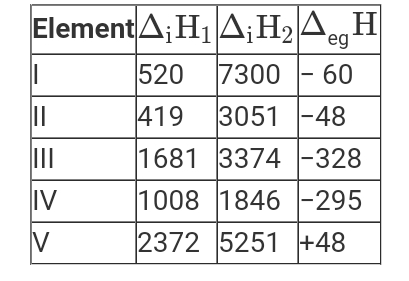The first and second ionization enthalpies (in kJ/mol) and electron gain enthalpy (in kJ/mol) of few elements are given below:
Which of the following is likely to be an alkali metal?
I
II
III
IV
Ist IE small and 2nd IE very high so Ist is alkali metal.
Topper's Solved these Questions
- TEST PAPERSBOOK - BANSALCHAPTER - TEST PAPERSEXERCISE - CHEMISTRY PART (A)
14 Videos
- TEST PAPERSBOOK - BANSALCHAPTER - TEST PAPERSEXERCISE - CHEMISTRY PART (B)
1 Videos
- TEST PAPERSBOOK - BANSALCHAPTER - TEST PAPERSEXERCISE - Chemistry PART D
4 Videos
- SOLUTIONSBOOK - BANSALCHAPTER - SOLUTIONSEXERCISE - Exercise4
32 Videos
- THERMOCHEMISTRYBOOK - BANSALCHAPTER - THERMOCHEMISTRYEXERCISE - Exercise 4
15 Videos
Similar Questions
The first (ΔiH1) and second (ΔiH2) ionisation enthalpies (inkJmol−1) and the (ΔegHө) electron gain enthalpy (inkJmol−1) of a few elements are given below:
Elements(ΔiH1)(ΔiH2)ΔegHөI5207300−60II4193051−48III16813374−328IV10081846−295V23725251+48VI7381451−40
Which of the above elements is likely to be
a. the least reactive element.
b. the most reactive metal.
c. the most reactive non-metal.
d. the least reactive non-metal.
e. the metal which can form a stable binary halide of the formula MX (X=halogen).
f. the metal which can form a predominantly stable covalent halide of the formula MX(X=halogen).
View SolutionThe first (ΔiH1) and second (ΔiH2) ionisation enthalpies (inkJmol−1) and the (ΔegHө) electron gain enthalpy (inkJmol−1) of a few elements are given below:
Elements(ΔiH1)(ΔiH2)ΔegHөI5207300−60II4193051−48III16813374−328IV10081846−295V23725251+48VI7381451−40
Which of the above elements is likely to be
a. the least reactive element.
b. the most reactive metal.
c. the most reactive non-metal.
d. the least reactive non-metal.
e. the metal which can form a stable binary halide of the formula MX2 (X=halogen).
f. the metal which can form a predominantly stable covalent halide of the formula MX(X=halogen).
View Solution
Knowledge Check
The first (ΔiH1 and second (ΔiH2 ionization enthalpies (in kJ/mol) and electron gain enthalpy (in kJ/mol) of few elements are given below:
ElementsΔiH1ΔiH2ΔegHI5207300−60II16813374−328III8991757+48IV23725251+48
Which of the above is likely to be He:AIBIICIIIDIVThe first (ΔIH1) and second (ΔIH2) ionisation enthalpies (in kJ mol−1) and the (ΔegH) electron gain enthalpy (in kJ mol−1) of a few elements are given below:

The least reactive element is :APBQCRDTThe first (ΔiH1) and second (ΔiH2) ionization enthalpies (in kJ mol−1) and the electron gain enthalpy (ΔegH)(in kJ mol−1) of the elements I, II, III, IV and V are given below

the least reactive non - metal and the most reactive metal of these are respectivelyAIV and VBII and VCV and IIIDV and II
The first (IE1) and second (IE2) ionisation energies (kJmol−1) of a new element designated by roman numericals are shown below:
(IE1)(IE2)I23725251II5207300III9001760IV16803380
Which of these elements is likely to be (a) a reactive metal, (b) a reactive non-metal, (c) a noble gas and (d) a metal that forms a binary halide of the formula, AX2.
View SolutionThe first (IE1) and the second (IE2) ionization enthalpies (kJ mol−1) of a few elements designated by Roman numerals are shown below:
ElementIE1IE2I23725251II5207300III9001760III9001760IV16803380
Which of the above elements is likely to be a,
metal that forms a stable binary halide of the formula AX2(X=halogen)
View SolutionThe first (IE1) and the second (IE2) ionization enthalpies (kJ mol−1) of a few elements designated by Roman numerals are shown below:
ElementIE1IE2I23725251II5207300III9001760III9001760IV16803380
Which of the above elements is likely to be a,
metal that forms a stable binary halide of the formula AX2(X=halogen)
View SolutionThe first (IE1) and the second (IE2) ionization enthalpies (kJ mol−1) of a few elements designated by Roman numerals are shown below:
ElementIE1IE2I23725251II5207300III9001760III9001760IV16803380
Which of the above elements is likely to be a,
reactive metal
View SolutionThe first (IE1) and the second (IE2) ionization enthalpies (kJ mol−1) of a few elements designated by Roman numerals are shown below:
ElementIE1IE2I23725251II5207300III9001760III9001760IV16803380
Which of the above elements is likely to be a,
reactive non metal
View Solution
